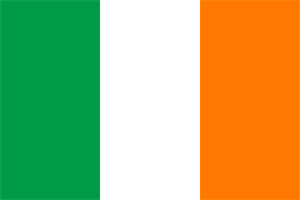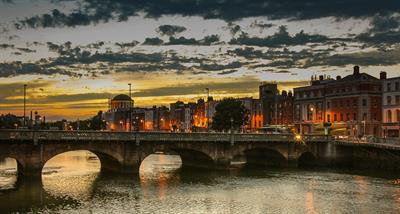Read the information, listen and learn or repeat words and expressions about Ireland.
(Lasi, klausies un iemācies vai atkārto vārdus par Īriju!)

- Ireland
Ireland also known as the Republic of Ireland is a European country on the island of Ireland. The country is sometimes called the Republic of Ireland in order to distinguish between the territory of the Irish state and island proper, but Ireland is its official name. It covers about five-sixths of the island of Ireland. The other sixth is called Northern Ireland, which is still part of the United Kingdom. The republic's capital is Dublin, which is located on the eastern side of the island. The sovereign state shares its only land border with Northern Ireland, a part of the United Kingdom. It is otherwise surrounded by the Atlantic Ocean, with the Celtic Sea to the south, St George's Channel to the south-east, and the Irish Sea to the east.
The first sights of people once lived in the island of Ireland was found from 3000 BC. The first Celts arrived from parts of Gaul and Britain around 700 BC. The Christianity reached Ireland around 350 and Saint Patrick arrived there in 432. He confronted King Laoghaire who allowed him to spread the word of Christianity in Ireland. Vikings occupied the island, as Great Britain, in 795, but Irish king Brian Boru defeated them at Clontarf in 1014. During the 11th and 12th centuries Ireland was divided into small counties ruled by different landlords. Then Dermot MacMurrough, the exiled king of Leinster sought the help from 'Strongbow' and in 1172 King Henry II of England was declared Feudal Lord of Ireland by the Pope. Till the early 20th century Ireland was as a part of Great Britain Kingdom. The state was created as the Irish Free State in 1922 as a result of the Anglo-Irish Treaty.
Ireland — [ˈaɪə.lənd] — Īrija
the Republic of Ireland — [rɪˈpʌb.lɪk ˌəv ˈaɪə.lənd] — Īrijas Republika
the island of Ireland — [ˈaɪ.lənd ˌəv ˈaɪə.lənd] — Īrijas sala
- The flag of Ireland
The national flag of Ireland is a vertical tricolour of green, white and orange. It was intended to symbolise the inclusion and hoped-for union between Roman Catholics (symbolised by the green colour) and Protestants (symbolised by the orange colour) and the white as a colour united these two. It was not until 1916, when it was raised above Dublin's General Post Office, that the tricolour came to be regarded as the national flag. The flag was adopted by the Irish Republic during the Irish War of Independence (1919–1921). The flag's use was continued by the Irish Free State (1922–1937) and it was later given constitutional status under the 1937 Constitution of Ireland.

the flag of Ireland — [ˌflæɡ ˌəvˈaɪə.lənd] — Īrijas karogs
tricolour — [ˈtrɪk.əl.ər] — trīskrāsains
- Dublin
Dublin is the capital and largest city of Ireland. Situated on a bay on the east coast, at the mouth of the River Liffey, it lies in the province of Leinster.
There is archaeological debate regarding precisely where Dublin was established by the Gaels in or before the 7th century AD. Later expanded as a Viking settlement, the Kingdom of Dublin, the city became Ireland's principal settlement following the Norman invasion. The city expanded rapidly from the 17th century and was briefly the second largest city in the British Empire before the Acts of Union in 1800. Following the partition of Ireland in 1922, Dublin became the capital of the Irish Free State, later renamed Ireland.

Dublin — [ˈdʌblɪn] — Dublina
- Languages
The Irish Constitution describes Irish as the "national language", but English is the dominant language. Irish is spoken as a community language only in a small number of rural areas mostly in the west and south of the country, collectively known as the Gaeltacht.
Irish — [ˈaɪə.rɪʃ] — īru valoda
- People
The people who live or whose ancestors roots are in Ireland are called Irish.
Irishman — [ˈaɪə.rɪʃ.mən] — īrs
Irishwoman — [ˈaɪə.rɪʃˌwʊm.ən] — īriete
the Irish — [ˈaɪə.rɪʃ] — īri
Atsauce:
https://www.ireland.com/en-gb/
https://www.ireland-information.com/articles/brief-history-of-ireland.html